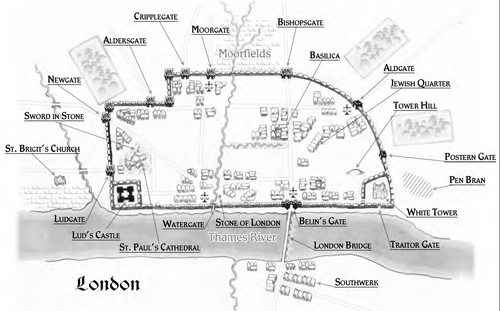| London | ||
| Ruler | City Council | |
| Part Of Kingdom Of | Logres | |
| Culture | Roman | |
London is the greatest city in Britain. Located within Silchester it is it's own legal entity and and owes allegiance only to the King of Logres.
London is very well defended with towers and walls that were built by Romans a century ago. It is surrounded by many smaller prosperous towns.
History[]
London is the first, largest, and most famous city in Britain. As all lettered men know, Prince Aeneas, a survivor of the sack of Troy, founded the Roman tribe. His great-grandson Brutus led a sea-borne migration of Trojan exiles westward and eventually settled on this island. The natives called their land Albion, but the conquerors changed its name to Brutusland, later corrupted to Britain.
Brutus built the city Troia Nova, or New Troy (later Trinovantes), as his capital. According to Geoffrey of Monmouth, this occurred at the same time that “the priest Eli was ruling in Judea and the Ark of the Covenant was captured by the Philistines” — i.e., sometime between 1115 and 1075 BC.
A thousand years later, shortly before the coming of Julius Caesar, King Lud fortified the city and changed its name to Kaerlud, or Fort of Lud. A century later, the Romans conquered the land; its name was corrupted to Kaerlundein, and eventually London.
To the native Cymric city the Romans added their own typical urban buildings: a legionary camp, basilica, coliseum, baths, and temples. They also built the famous London Bridge, which is the only bridge that spans the navigable parts of the Thames River.
Two castles help to protect London. At the west end is the Castle Lud, built over the old site of Kaerlud. At the eastern edge of the city is the White Tower, originally built by the Roman Emperor. The massive keep and castle serve as a royal residence and as refuge of last resort in times of war or uprising.
London is large and influential enough to be a political power in its own right. It is run by a city senate that determines internal affairs, such as judging its citizens in the city court rather than a king’s or nobleman’s court. The senate appoints leaders, called praetors, for specific tasks.
London rules over its surrounding countryside, the County of London, and also has its own permanent garrison, which also serves as night watch, police, and firemen. Although adequate for manning the walls, though, this standing army of footmen is inferior in the field. Since London has no expansionist ambitions, its relatively small military force has usually proved sufficient.
Map[]
Places of Interest[]
- Belinsgate: This gate is named after King Belinus, whose cremated remains in a golden urn are cemented into the arch of this gate.
- Bishopsgate: When King Lucius adopted Christianity in 166, his flamens (Latin for “priest,” i.e., druids) became bishops and the archflamens (archdruids) became archbishops. Ever since then, the Bishop of London has had his residence over this gate.
- London Bridge was built by the Romans, and is the only bridge to cross the Thames River for many miles in either direction. Made of stone, it has nineteen arches under which ships can sail.
- Lud’s Castle: The second castle of London.
- Per Bran, Location of the "Head of Bran." Bran was an ancient hero, and he ordered that his head be buried here in order to protect the island with its magical powers.
- Saint Paul's Cathedral: At the request of King Lucius, Saint Fagan and Saint Dyfan came to Britain in 166 to bring the Good News of Christ’s resurrection. London built its most famous church, Saint Paul's, which has been rebuilt over the centuries.
- Southwerk was originally just the defensive work around the south end of the bridge, but has since then grown to be a sprawling nest of perdition, vice, and desperate squalor.
- Stone of London: This stone marks the centre of the city. When Brutus established the city, this was the stone used for his first sacrifice to the goddess Diana. Later, the Romans used it as the original milestone from which to mark their roads.
- Tower Hill, located just outside the city, is the site for executing noble traitors.
- The White Tower, a very strong royal castle of medium size on the east side of London. Before the Romans, this was called the White Hill: Brutus was buried here. It is famous for the great ravens that live there, reputedly until the island is going to fall to invaders. It is held for the king of Logres by the powerful Constable of the White Tower, an officer of equivalent rank to a baron.
